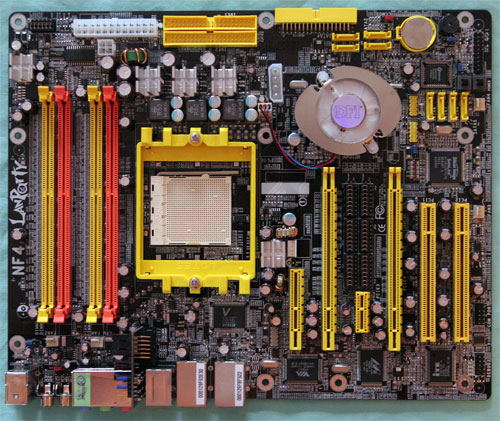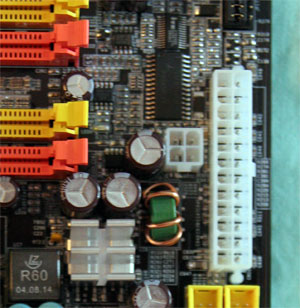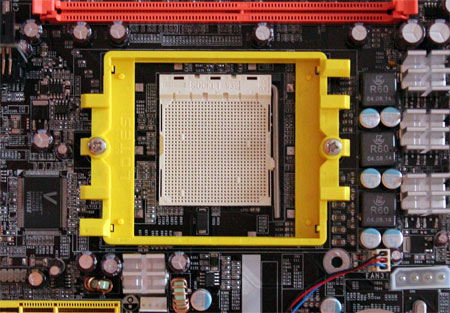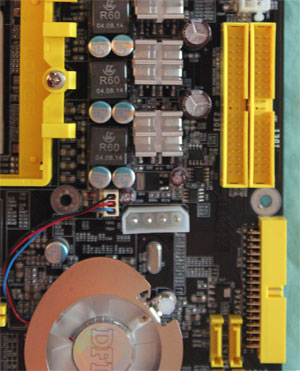DFI nForce4: SLI and Ultra for Mad Overclockers
by Wesley Fink on February 5, 2005 9:30 AM EST- Posted in
- Motherboards
Board Layout: DFI nForce4
Each new generation of DFI motherboards seem to be improving on board design, and the DFI nForce4 boards feature a very functional layout.

The DFI nF4 places the CPU in the top center of the board and DIMMs at the top. This arrangement worked well in our testing and should work better for those who change memory frequently than the crowded right edge location used on most boards.

The ATX 24-pin and the 4-pin 12V connector are in ideal locations on the DFI nF4. The bulky 24-pin ATX is located on the preferred top right edge of the motherboard, and the 4-pin 12V power connector is right beside it. This board-edge location keeps bulky cables away from the CPU and memory.

The CPU socket is in the top center of the board. PCI slots are below the socket and memory is above the CPU. There is plenty of room around the Socket 939, so most Heatsink/Fans should work fine. A Zalman 7000 overhung DIMM slot 4, but it still cleared our stock OCZ memory and dimms could work in all slots.

The IDE connectors are at our preferred upper right edge of the motherboard, and the floppy connector is a board edge connector about right midline of the board. Both locations are nearly ideal and worked well in our testing. If you use a floppy drive, you might want to connect the floppy before screwing down the board, as many mid-tower cases are tight in the area of the floppy connector. Having said that, we would still choose this floppy location any day over the floppy placed at the bottom of the board.

SATA connectors are to the right of the nF4 chipset and the magnetic levitation fan. The fan is low enough for video cards - both ATI and nVidia - to mount properly. We tried both ATI and nVidia top-of-the line cards to make sure.

Most competitive boards with 2 x16 PCIe video slots use a simple card edge selector that is reversed for SLI operation. DFI uses 6 jumper blocks that must all be moved to switch to SLI mode.
DFI also continues CMOS reloaded, which was introduced with the second generation LANParty boards. This feature allows you to save several different custom BIOS set-ups so that you can recall custom BIOS settings easily for a particular overclock or settings for a different OS. Overclockers and users who run multiple operating systems will really find CMOS Reloaded to be a useful feature.










114 Comments
View All Comments
bigtoe36 - Wednesday, February 2, 2005 - link
regarding the NF3 939 i hear NF3 may disapear soon so we may never see an AGP version of this board.Wesley Fink - Wednesday, February 2, 2005 - link
DFI has advised that the final nF4 product line will consist of 3 models. The information on page 2 has been revised to reflect the latest information.bigtoe36 - Wednesday, February 2, 2005 - link
The extra molex is to add extra power to the board especially when using 2 video cards.The chipset fan is very quiet and does work quite well. When stressed the chipset does get quite warm though but I have seen no instability on my boards here and all use stock chipset cooling.
The board will work with 20 and 24 pin ATX connectors.
The SLI bridge can only be sold with SLI boards, you will be able to but it seperately though.
jwix - Wednesday, February 2, 2005 - link
I've been waiting and waiting and waiting for this board. Finally, Anandtech posts this review late last night just as someone posts in the forum that the board is stocked at ZZF. I surf to ZZF. Indeed, the board is in stock. I quicky read the review then return to ZZF to buy. Board is out of Stock. *sigh* I'm betting the price of this board goes up before it goes down.LoneWolf15 - Wednesday, February 2, 2005 - link
A good review overall. Some questions I'd have liked to see answered though:a)As others have said, what is the 5.25" Molex power connector on the board for?
b)ATX power connectors - does the board require the 24-pin, or, like other boards, will a 20pin +4pin P4 connector run it just fine?
c) I'd have liked a little more detail on the maglev chipset fan, was it noisy, the design, etc. I'm being picky, but it's a new feature and all of us get annoyed when a northbridge HSF fails, especially if it's in a location where you can't replace it with just anything due to expansion cards.
d)Question on the SLI finger-board: It seems like it doesn't come with the non-SLI boards, if it doesn't, how useful is it to be able to convert this to SLI? I've not seen retailers selling them separately.
I like the boards. Only minor gripe is, I still need an onboard serial port, I use it for things like configuring a router now and again. Hopefully they include a backplate for it at least, though I'd doubt it.
Burbot - Wednesday, February 2, 2005 - link
#22: It would be a good idea to look back at history of industries. When was the last time a sprinter broke a record by 8%? Probaby in first days of organized sprint. When was the last time processor speed increased by 8%? Every A64 200MHz speedbump gave slightly bettter improvements. 8% is difference between 2.4 and 2.6 GHz Athlon FX. Does one demolish the other? Or it is "merely" a fair improvement? I side with the latter.I do not want to diminish DFI effort, but I'd reserve "demolished" to huge improvements, as in "that A64 machine demolishes my Duron box".
lsman - Wednesday, February 2, 2005 - link
#14. it provides extra current when under SLI mode so its more "stable"Aquila76 - Wednesday, February 2, 2005 - link
I've said it before, I'll ask for it again:SLI Mobo Roundup.
Please.
byvis - Wednesday, February 2, 2005 - link
The board is nice, but not outstanding, incredible, top performing, etc... Jesus AnandTech I have never seen you so biased. I hope that the benchmarks don't lie. Poor preview, poor...Wesley Fink - Wednesday, February 2, 2005 - link
ChineseDemocrcyGNR - Thank you for all your replies to reader's questions.#22 - Good analogy and a very accurate descrip-tion of breaking records at the top end. New CPU's are often hyped to the heavens and often they don't even do 8% more performance than the one they replace. Breaking new ground at the top is quite different than 8% in the middle.